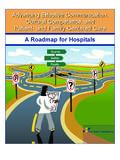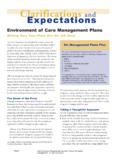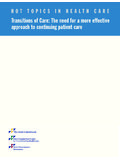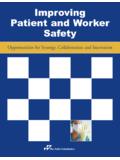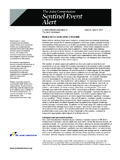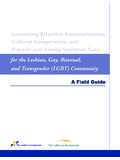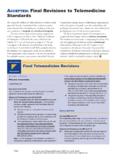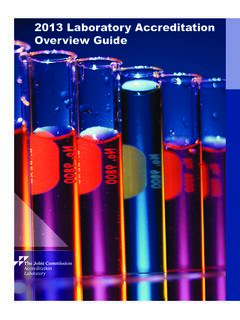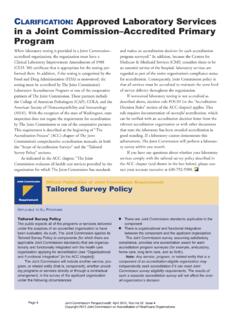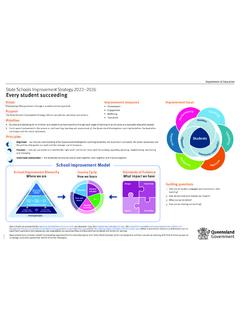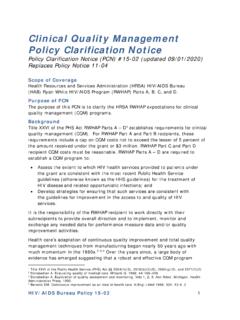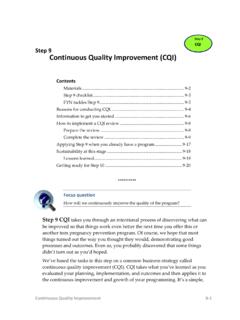Transcription of New and Revised Performance Improvement Accreditation ...
1 A complimentary publication of The Joint Commission Issue 31, June 18, 2021. Published for Joint Commission-accredited organizations and interested health care professionals, R3 Report provides the rationale and references that The Joint Commission employs in the development of new requirements. While the standards manuals also may provide a rationale, R3 Report goes into more depth, providing a rationale statement for each element of Performance (EP). The references provide the evidence that supports the requirement. R3 Report may be reproduced if credited to The Joint Commission.
2 Sign up for email delivery. New and Revised Performance Improvement Accreditation Standards Effective January 1, 2022, the Performance Improvement Accreditation standards for ambulatory care, behavioral health care and human services, critical access hospitals, home care, hospitals, laboratories, nursing care centers, and office-based surgery practices will include several revisions. There will be one new standard with two elements of Performance (EPs) and one new element of Performance added to an existing standard. Introduction of the new standard and EPs has resulted in revisions to other existing standards and EPs to reinforce the connection between all the Performance Improvement requirements.
3 These proposed revisions aim to strengthen the link between leadership priorities and goal setting and planning organizational quality assessment and Performance Improvement efforts. In addition, the proposed revisions encourage use of Improvement tools or methodologies to achieve and sustain improved Performance . The Joint Commission evaluated literature, reviewed compliance data, and reviewed ORYX and other publicly available quality measures to determine how health care organizations are using Performance data and Performance Improvement tools and strategies.
4 Two common themes emerged among organizations with successful Improvement programs: 1. They adopted an established Improvement methodology and used the associated tools in their efforts. 2. They developed and maintained relevant and manageable plans for monitoring quality and prioritizing Improvement initiatives. Organizational leaders play a critical role in the success of Performance Improvement efforts. Planning is key to harnessing the power of data. Deciding what data is important for the organization to monitor and how frequently, along with recognizing when the data is suggesting further action is an important responsibility for any leadership team.
5 Useful data are analyzed and presented in an effective way that makes it easy for leaders to recognize potential Performance concerns that require action. An example of available, ready-to-use data can be found in The Joint Commission's DASH initiative (Data Analytics for Safe Healthcare) in the Accelerate PI tool and the SAFER Dashboard. Tools like these help identify risk areas and support organizational efforts to focus on the most critical issues impacting patient safety and the quality of care. The prepublication version of the Performance Improvement standards will be available online until December 31, 2021.
6 After January 1, 2022, please access the new requirements in the E-dition or standards manual. 2021 The Joint Commission Issue 31, June 18, 2021 Page 2 New and Revised Performance Improvement Accreditation Standards Performance Improvement : The [organization] has a written plan that describes quality measurement and Performance Improvement activities. Requirement EP 1: Performance Improvement priorities established by [organization] leaders are described in a written plan that includes the following: The defined process(es) needing Improvement , along with any stakeholder (for example, patient staff, regulatory) requirements, project goals, and Improvement activities Method(s) for measuring Performance of the process(es) identified for Improvement Analysis method(s) for identifying causes of variation and poor Performance in the process(es).
7 Methods implemented to address process deficiencies and improve Performance Methods for monitoring and sustaining the improved process(es). Requirement EP 2: Leadership reviews the plan for addressing Performance Improvement priorities at least annually and updates it to reflect any changes in strategic priorities and in response to changes in the internal or external environment. Rationale Health care leaders decide on the organization's quality strategy for its various care settings. The strategy must include a robust, comprehensive systems approach in order to carry out efforts to improve care processes (Chassin and Loeb, 2013; Scoville and little, 2014; Valentine and Falk, 2018; Gandhi et al.)
8 , 2020). Successful efforts have demonstrated that planning is essential to achieving and sustaining improved Performance . Plans that include desired goals and identify which data to collect along with timelines for measurement and Improvement activities tend to both achieve and sustain change (Chen 2019; McLees et. al., 2015; Nakhleh et al, 2015). Reference* Chassin, & Loeb, (2013). High-Reliability Health Care: Getting There from Here. The Milbank Quarterly. 91(3). 459-490. Chen, P. G., Harrison, M. I., Bergofsky, L. R., St Clair, D.
9 , Mardon, R., Raaen, L., & Friedberg, M. W. (2019). Use of Internal Performance Measurement to Guide Improvement Within Medical Groups. Jt Comm J Qual Patient Saf, 45(7), 487-494. Gandhi, T. K., Feeley, D., & Schummers, D. (2020). Zero Harm in Health Care. NEJM. Catalyst, 1(2). McGrath, S. P., & Blike, G. T. (2015). Building a Foundation of Continuous Improvement in a Rapidly Changing Environment: The Dartmouth-Hitchcock Value Institute Experience. The Joint Commission Journal on quality and Patient Safety, 41(10), 435-AP433. (15)41056-6.
10 McLees, , Nawak, S., Thomas, C., & Young, A. (2015). Defining and Assessing quality Improvement Outcomes: A Framework for Public Health. American Journal of Public Health 105(S2), S167-S173. Nakhleh, R. E., Souers, R. J., Bashleben, C. P., Talbert, M. L., Karcher, D. S., Meier, F. A., & Howanitz, P. J. (2014). Fifteen years' experience of a College of American Pathologists program for continuous monitoring and Improvement . Arch Pathol Lab Med, 138(9), 1150-1155. 0148-OA. 2021 The Joint Commission Issue 31, June 18, 2021 Page 3 New and Revised Performance Improvement Accreditation Standards Reference* Scoville, R.

